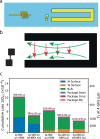Surpassing millisecond coherence in on chip superconducting quantum memories by optimizing materials and circuit design
- PMID: 38693124
- PMCID: PMC11063213
- DOI: 10.1038/s41467-024-47857-6
Surpassing millisecond coherence in on chip superconducting quantum memories by optimizing materials and circuit design
Abstract
The performance of superconducting quantum circuits for quantum computing has advanced tremendously in recent decades; however, a comprehensive understanding of relaxation mechanisms does not yet exist. In this work, we utilize a multimode approach to characterizing energy losses in superconducting quantum circuits, with the goals of predicting device performance and improving coherence through materials, process, and circuit design optimization. Using this approach, we measure significant reductions in surface and bulk dielectric losses by employing a tantalum-based materials platform and annealed sapphire substrates. With this knowledge we predict the relaxation times of aluminum- and tantalum-based transmon qubits, and find that they are consistent with experimental results. We additionally optimize device geometry to maximize coherence within a coaxial tunnel architecture, and realize on-chip quantum memories with single-photon Ramsey times of 2.0 - 2.7 ms, limited by their energy relaxation times of 1.0 - 1.4 ms. These results demonstrate an advancement towards a more modular and compact coaxial circuit architecture for bosonic qubits with reproducibly high coherence.
© 2024. The Author(s).
Conflict of interest statement
L.F. and R.J.S. are founders and shareholders of Quantum Circuits Inc. (QCI). The remaining authors declare no competing interests.
Figures






References
LinkOut - more resources
Full Text Sources

